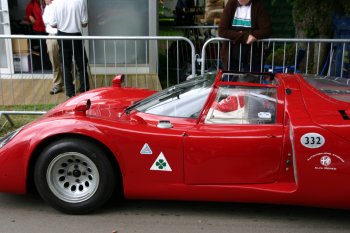|
A major
highlight of the Goodwood Festival of Speed each year for
both the many
Alfisti and the general public who cram this popular
event is the presence of the Museo Storico Alfa Romeo; and
this year as usual they didn't disappoint with a
five-strong line-up of cars led out by the race-winning 33/2
'Daytona'.
One of Alfa
Romeo's most positive policies today is that it doesn't hide
its mouth watering inventory of highly successful historic road and
racing cars away in the official museum; rather they take
part in a hectic programme of high profile events worldwide each year
such as the mow superbly revived 1000 Miglia and Targa Florio. And the
Goodwood Festival of Speed, which has grown to become the
greatest celebration of automotive achievement through the
decades in the world, has become a regular date on the cramped calendar of
the Museo Storico, especially so as Alfa Romeo is a sponsor
of the event. "It's an important event because of the
interest of the British public," a Museo spokesperson told
Italiaspeed. "Its a real face to face meeting for
people who are always interested in the work these guys are
doing."
This year the
Museo Storico's two huge transporters turned up at Goodwood
with five racing cars, each with its place long since etched into
motor racing history, each a comprehensive winner in its day. Lined up in the Cathedral
Paddock, the oldest member of the quintet was the glorious P2 Gran Premio which was built in 1924. With its 2.0-litre straight
8-cyl supercharged twin-cam engine it developed 175 bhp and
had a top speed of 141 mph. Its first victories came at the
1924 Italian and Cremona Grand Prix, where it was driven by
Antonio Ascari, and at the Grand Prix of Europe, in the hands
of Giuseppe Campari. The very next year it won the World
Championship. At Goodwood it was entered in Batch 1, Class 3
Rise of the Single Seater - Celebrating 75 years since
the 'monoposto' changed GP racing and was powered up the
hill on all three days by Maurizio Monti.
Next up in
chronological order was the Gran Premio Tipo B 'P3' from
1932. With its 2654cc straight 8-cyl twin-supercharged
engine it boasted 215 bhp and achieved a top speed of 144 mph. Originally
known as the Tipo B, legendary Alfa Romeo engineer Vittorio
Jano's P3 represented a milestone in the marque's racing
history, winning its Grand Prix debut at Monza in 1932
driven by Nuvolari, and remaining unbeaten in 1933. At
Goodwood, where it was driven up the hill by Richard Gadeselli, it was the
Museum's second entry in Batch 1, Class 3.
|
 |
|
The Goodwood Festival of Speed, which has grown to
become the greatest celebration of automotive
achievement through the decades has become a regular
date on the cramped calendar of the Museo Storico. |
|
 |
|
|
 |
|
A major
highlight of the Goodwood Festival of Speed each year for
Alfisti is the presence of the Museo Storico Alfa Romeo,
and this year as usual it didn't disappoint with a
five-strong line-up led out by the race-winning 33/2
'Daytona' (above). |
|
 |
|
|
The third and
final single seater to be brought to Goodwood by the
Automobilismo Storico team was arguably the most famous Alfa Romeo
Grand Prix racer of all time, the Alfa 159 'Alfetta'. Built in 1951 the
story of its F1 World Championship win that year in the
hands of Argentinean maestro Juan-Manuel Fangio is now the
stuff of legend. Powered by a 1.5-litre in-line twin cam
engine and fitted with two superchargers it developed an
impressive 425 bhp and achieved more than 191 mph. The Alfa
159, which was driven at the Festival by Alessandro Rigoni,
was entered in Batch 3, Class 8 Classic GP Cars - front
engined GP cars of the post-war era.
Complementing
the trio of single-seaters were a pair of sports cars, which
could also boast a winning pedigree. The 186 mph 33/2
'Daytona', powered by a 270 bhp 2.0-litre V8 twin-cam engine,
was built for the 1968 International Constructors'
Championship, and these cars achieved a dramatic 1-2 finish
in the Daytona 24 Hours, immediately earning itself a place
in history. The 33/2 was entered in Batch 2, Class 6 International
sports cars - Iconic sports racers that competed between
1960 and 1980, and was ,driven by Andew English. The second
entry in this class, and the final car to be brought to
Goodwood from the Museo was the 33 TT 12 which in 1975 won
seven out of eight races on its way to the World
Manufacturers' title. Characterised by the slippery wedge
shape prevalent of that era, the 33 TT 12 was powered by a
300 bhp flat-12 twin-cam engine,, it turned out a massive 500
bhp at 11,000 rpm and was able to top 206 mph. It was driven
on the course at the weekend by S Chatzipanagiotou.
Just like
everyone else the heavy rain affected the Museo cars. "We
went out this morning with the P3, 159 and Daytona and it
was absolutely fine," said a Museo spokesperson on Saturday
afternoon, "but this afternoon when we tried the P2 and P3
in the hailstorm water was coming in from underneath as well
as on top and there isn't enough grip on those tyres to
start throwing them up the hill. The racing cars are leaving
a lot of rubber on the track, and with all the rain, its
becoming very slippery."
|
|
|
|